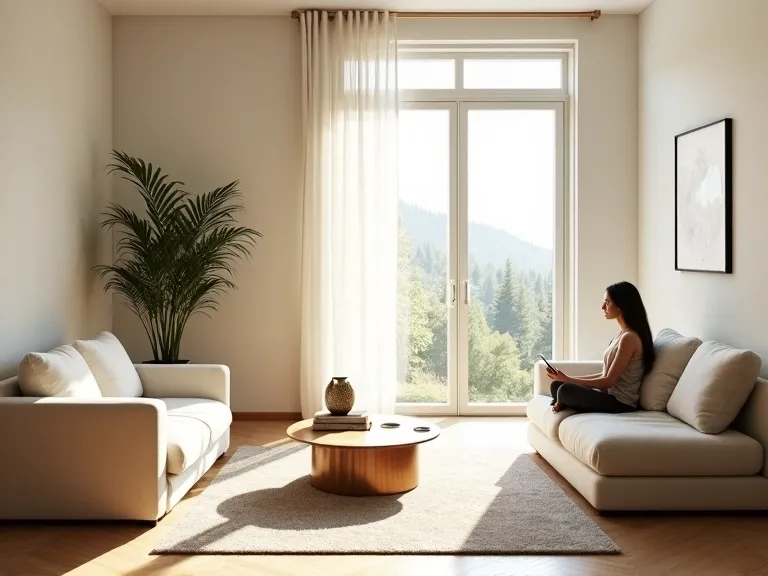In a world where we are constantly bombarded with advertisements, new products and the constant pressure to have more, the daily reality of many of us has become an overwhelming chaos of objects, obligations and stress. Do you sometimes wonder if you really need everything around you? Are your closets, drawers and digital spaces bursting at the seams with excess... things that were supposed to bring happiness, but have only brought fatigue? Minimalism is not just a fashionable trend, but an actual, real way to regain control over your own life. In this article, you will learn 7 proven methods that will help you introduce a minimalist approach to your everyday life - without radical changes, but with tangible benefits for your well-being, your wallet and the environment.
What is minimalism and its main assumptions
Minimalism is a philosophy and lifestyle that focuses on reducing unnecessary elements and striving for simplicity. It is not just an aesthetic trend, but a conscious choice to reject excess in favor of what is truly valuable. Have you ever wondered how many things in your environment actually serve a purpose, and how many are simply taking up space?
The main principles of minimalism include a conscious approach to possessions, eliminating unnecessary items, and focusing on quality over quantity. Minimalists believe that less is more – less stuff means less worries, less cleaning, fewer decisions, and more freedom. Minimalism does not require giving up everything, but only keeping what adds value to our lives. What in your life brings you true joy and what do you keep “just in case”?
Practicing minimalism leads to greater consumer awareness, better financial management, and often to improved interpersonal relationships. When we stop focusing on accumulating material things, we have more time, energy, and space to pursue passions, build meaningful relationships, and take care of our own mental health. Today's challenge: Choose one drawer in your home and go through its contents, asking yourself for each item, "Does this really enrich my life?"
Organizing Space - Practical Decluttering Methods
Decluttering is a process that for many people is not only a way to organize space, but also a path to inner peace and harmony. Unlike chaotic hoarding, which is overwhelming and limiting, consciously reducing excess items is liberating and gives a sense of control over your own environment. When our space is tidy, our mind can also rest and focus on what is really important.
Fundamental principles of decluttering
Effectively organizing your space relies on a few key principles that help you go from overwhelming clutter to functional space. A methodical and systematic approach always brings better results than a chaotic attempt to clean everything at once.. It's worth remembering that the decluttering process is a marathon, not a sprint – it requires patience and consistency.
The KonMari Method
Created by Marie Kondo, the KonMari method offers a categorical approach to tidying up. Instead of tidying up room by room, we deal with categories: clothes, books, documents, mementos, and other items. The key question is: “Does this item spark joy?” If not, we get rid of it with gratitude for the service it provided us.
System 20/10
For those who feel overwhelmed by the thought of tidying up, Rachel Hoffman’s 20/10 system can be a godsend. It involves working for 20 minutes, then taking a 10-minute break. This rhythm helps avoid burnout and makes tidying up less stressful.
"Less is more. Simplifying is not giving up on well-being, but consciously choosing quality over quantity."
Practical implementation techniques
Introducing decluttering into everyday life requires not only a one-time cleaning action, but also a change of habits. Regular inspections of your belongings this is the basis of keeping order. We can start with the rule "one item in, one item out" - every time we buy something new, we get rid of one similar item.
Digital Decluttering
In the digital age, clutter isn’t limited to physical objects. Overflowing email inboxes, thousands of unused apps, and dozens of open browser tabs also create mental chaos. Regularly cleaning your digital spaces is just as important as tidying up your physical surroundings, maybe even more so, because digital clutter is less visible but just as mentally taxing.
A minimalist approach to consumption and shopping
Key points:
- Conscious consumption means buying according to real needs, not momentary whims.
- The “one in, one out” rule helps keep items in your home in balance
- Minimalist shopping is an investment in fewer, but better quality products.
A minimalist approach to consumption is not only a way to keep your home space tidy, but also a path to greater financial and mental freedom. In a world where we are constantly bombarded with advertisements and incentives to buy, consciously limiting consumption becomes a form of liberation. Instead of mindlessly accumulating more items, minimalists ask themselves, “Will this purchase actually enrich my life?”
One of the most effective strategies for implementing minimalist shopping is the “one out, one in” rule. This means that every time you buy a new item, you get rid of one you already have. This simple rule helps maintain a constant number of items in your environment and forces you to think before each new purchase. Additionally, it’s worth introducing a 24-hour delay for larger purchases – when you give yourself time to think, it often turns out that the initial impulse was momentary.
“We are not what we possess. The things we accumulate eventually come to possess us.”
Minimalist shopping also means changing your perspective from quantity to quality. Instead of buying lots of cheap items that quickly break down or go out of style, minimalists choose fewer things, but of better quality. They invest in durable, timeless and multifunctional items. Paradoxically, this approach often turns out to be more economical in the long run – one solid product can serve for years, replacing several cheaper equivalents.
It is also worth paying attention to the ecological aspect of a minimalist approach to shopping. By limiting consumption, we reduce our carbon footprint and the amount of waste generated. By choosing products from local manufacturers, we support the local economy and reduce emissions related to transport. Consumer minimalism is therefore not only a personal lifestyle choice, but also an attitude of social responsibility and concern for the natural environment.
Digital Minimalism – How to Organize Your Online Life
In the digital age, we are bombarded with hundreds of notifications, apps and social networking sites. Digital Minimalism is not just a fashionable trend, but a practical approach to regaining control over your digital life. Contrary to popular belief, digital minimalism does not mean completely giving up technology – that is a myth that needs to be debunked.
Many people mistakenly believe that digital minimalism requires a radical break from the internet and technology. In reality, it is conscious and purposeful use of digital tools that actually add value to our lives. You don’t have to throw away your smartphone to become a digital minimalist – rather, you should learn to control when and how you use it.
"Technology should be a tool in your hands, not a constant distraction. You can enjoy the benefits of the digital world without being its slave."
Practical digital minimalism can start with simple steps. You could start by deleting apps that you don’t use regularly. You should also consider turning off unnecessary notifications that constantly interrupt your day. It’s also worth doing regular “digital cleaning” – from time to time, you should review your email subscriptions, social media accounts you follow, and installed apps.
Digital minimalism can significantly improve your quality of life, increase your focus, and reduce your stress levels. However, it’s important to remember that this is a process, not a one-time action. Your digital habits have been formed over the years and may take time to change. With each conscious online choice, you can gradually regain control over your digital life.
The benefits of a minimalist lifestyle
What if each of us got rid of field your stuff? Imagine a morning without frantically searching through your closet for clothes, without struggling with mountains of unnecessary items and without the constant feeling that your apartment is literally drowning in chaos. Minimalism is not just a trend – it is a revolution in thinking that can free you from the slavery of consumerism and restore control over your life.
The greatest wealth is not what we own, but the mental space that we regain by giving up excess.
A minimalist lifestyle brings benefits that are simply overwhelming. unimaginable for those who have never tried it. Less cleaning, more money in your wallet, lower stress levels and an ocean of free time - this is just the beginning of a long list. Studies show that people who live by minimalist principles experience deeper satisfaction with life and have a clearer mind. When we stop surrounding ourselves with thousands of unnecessary objects, we will discover that our attention and energy can be directed to the things that really matter - relationships, passions and personal development.
Minimalism – The Path to Conscious Living
Minimalism is not just a fashionable trend but a practical way to regain control over your life. By eliminating excess items and obligations, we can focus on what is truly important and valuable. Conscious decisions about what we own and what we surround ourselves with lead to greater peace and fulfillment.
Benefits of a minimalist approach:
| Living area | Benefits of minimalism | Psychological effect |
|---|---|---|
| Home space | Less cleaning and tidying up | Reduced stress levels |
| Finances | Less spending on unnecessary things | Greater sense of security |
| Time | Fewer obligations and distractions | More space for passions and relationships |
Start your minimalism journey today! Start small – choose one drawer or shelf to organize. Get rid of things you don’t use or love. Over time, expand this practice to other areas of your life.
Ready for a change? Download our free guide “30 Days to a Simpler Life” and join a community of people who have discovered the value of having less to live more!
Frequently asked questions
What is the best way to start your adventure with minimalism?
It's best to start with one room, usually a bedroom, where the silence of objects will allow you to hear your own thoughts. Start by removing things you haven't used in the past year, and you'll feel a slight taste of freedom.
Does minimalism mean I have to get rid of all my stuff?
Absolutely not, minimalism is not a cold void, but a warm space where every item has its place and purpose. It's about consciously choosing what really resonates in your life, not about drastically getting rid of everything.
How to convince your family to adopt a minimalist lifestyle?
Instead of imposing bittersweet changes, show your loved ones tangible benefits – more time, less cleaning, a brighter space that smells of peace. Your own example and patience often speak louder than the most colorful arguments.







